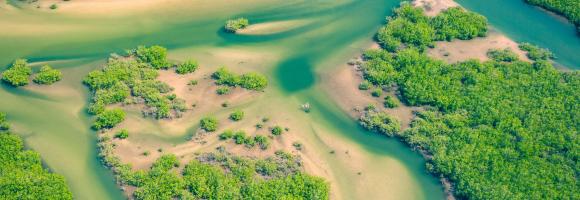
Mangroves provide both climate change mitigation and adaptation services. They provide benefits for coastal communities and they are among the most effective carbon-capture ecosystems. If they are degraded or cleared, the carbon stored will be released into the atmosphere as CO2 and it will exacerbate climate changes. Target 8 of the First Draft of the Post-2020 Global Biodiversity Framework said: “Minimize the impact of climate change on biodiversity, contribute to mitigation and adaptation through ecosystem-based approaches, contributing at least 10 GtCO2e per year to global mitigation efforts, and ensure that all mitigation and adaptation efforts avoid negative impacts on biodiversity.” Mangrove habitats contribute to climate mitigation targets. This layer wants to show the percentage of total carbon stored in mangroves per ACP country in comparison with the global mangrove total organic carbon stored.
Source: Global Mangrove Watch
Bunting, Pete, Rosenqvist, Ake, Lucas , Richard, Rebelo, Lisa-Maria, Hilarides, Lammert, Thomas, Nathan, Hardy, Andy, Itoh, Takuya, Shimada, Masanobu, & Finlayson, Max. (2019). Global Mangrove Watch (1996 - 2016) Version 2.0 (2.0)
Giri, C., Ochieng, E., Tieszen, L. L., Zhu, Z., Singh, A., Loveland, T., … Duke, N. (2011). Status and distribution of mangrove forests of the world using earth observation satellite data. Global Ecology and Biogeography, 20(1), 154–159
Sanderman J, Hengl T, Fiske G et al. (2018) A global map of mangrove forest soil carbon at 30 m spatial resolution. Environmental Research Letters 13: 055002
Simard, M., T. Fatoyinbo, C. Smetanka, V.H. Rivera-monroy, E. Castaneda-mova, N. Thomas, and T. Van der stocken. (2019) Global Mangrove Distribution, Aboveground Biomass, and Canopy Height. ORNL DAAC, Oak Ridge, Tennessee, USA
---
Data Uploaded by Simona Lippi using the BIOPAMA Services (2022)